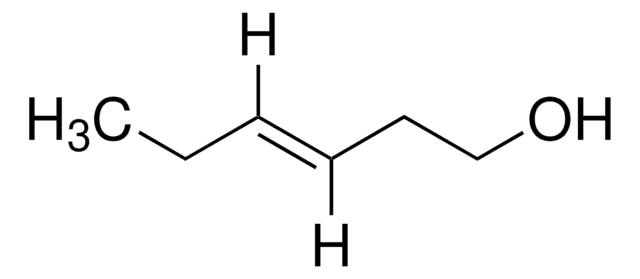All Photos(1)
About This Item
Linear Formula:
C2H5CH=CHCH2CH2OH
CAS Number:
Molecular Weight:
100.16
Beilstein/REAXYS Number:
1719712
EC Number:
MDL number:
UNSPSC Code:
85151701
PubChem Substance ID:
NACRES:
NA.24
Recommended Products
grade
analytical standard
Quality Level
vapor density
3.45 (vs air)
assay
≥96.0% (GC)
shelf life
limited shelf life, expiry date on the label
technique(s)
HPLC: suitable
gas chromatography (GC): suitable
refractive index
n20/D 1.44 (lit.)
n20/D 1.440
bp
156-157 °C (lit.)
density
0.848 g/mL at 25 °C (lit.)
application(s)
cleaning products
cosmetics
flavors and fragrances
food and beverages
personal care
format
neat
SMILES string
CC\C=C/CCO
InChI
1S/C6H12O/c1-2-3-4-5-6-7/h3-4,7H,2,5-6H2,1H3/b4-3-
InChI key
UFLHIIWVXFIJGU-ARJAWSKDSA-N
Looking for similar products? Visit Product Comparison Guide
Related Categories
Application
Refer to the product′s Certificate of Analysis for more information on a suitable instrument technique. Contact Technical Service for further support.
Packaging
Bottomless glass bottle. Contents are inside inserted fused cone.
Choose from one of the most recent versions:
Already Own This Product?
Find documentation for the products that you have recently purchased in the Document Library.
Customers Also Viewed
Miriam F Cooperband et al.
Journal of economic entomology, 112(2), 671-682 (2019-02-13)
The spotted lanternfly, Lycorma delicatula (White), is an invasive phloem feeder recently introduced into North America that attacks a broad range of woody plants. When feeding in large numbers, they can seriously damage or kill a tree. Their preferred host
Ai Ito et al.
Neuroscience research, 65(2), 166-174 (2009-07-01)
In the present study, on rats, a quantitative analysis of Fos protein immunohistochemistry was performed as a way of investigating the effects of inhalation of green odor (a mixture of equal amounts of trans-2-hexenal and cis-3-hexenol) on the neuronal activations
Peter de Groot et al.
Journal of chemical ecology, 34(9), 1170-1179 (2008-07-05)
Green leaf volatiles (GLVs) function as host attractants, pheromone synergists, or sexual kairomones for a number of coleopteran folivores. Hence, we focused on host GLVs to determine if they were attractive to adults of the emerald ash borer, Agrilus planipennis
Andre F Cruz et al.
Phytochemistry, 78, 72-80 (2012-04-24)
Fusarium diseases cause major economic losses in wheat-based crop rotations. Volatile organic compounds (VOC) in wheat and rotation crops, such as chickpea, may negatively impact pathogenic Fusarium. Using the headspace GC-MS method, 16 VOC were found in greenhouse-grown wheat leaves:
Shigehiro Namiki et al.
Journal of comparative physiology. A, Neuroethology, sensory, neural, and behavioral physiology, 194(5), 501-515 (2008-04-05)
Pheromone-source orientation behavior can be modified by coexisting plant volatiles. Some host plant volatiles enhance the pheromonal responses of olfactory receptor neurons and increase the sensitivity of orientation behavior in the Lepidoptera species. Although many electrophysiological studies have focused on
Our team of scientists has experience in all areas of research including Life Science, Material Science, Chemical Synthesis, Chromatography, Analytical and many others.
Contact Technical Service

